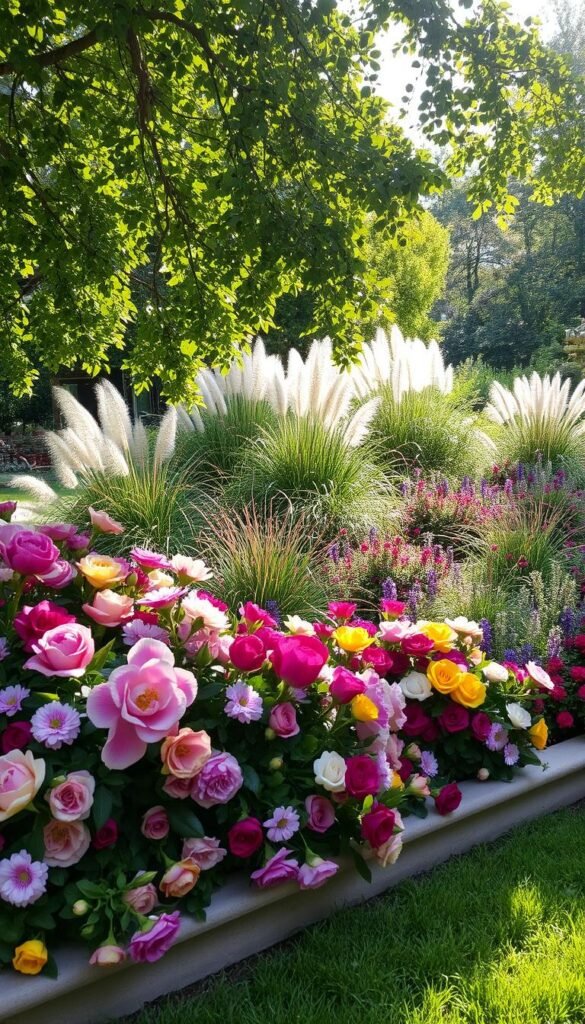Your outdoor sanctuary deserves more than random edges. Thoughtful edging acts like nature’s picture frame, turning scattered blooms into intentional designs. Just as art needs structure, your plants thrive with clear boundaries that guide growth and highlight colors.
Imagine crisp lines separating lush greenery from pathways or vibrant annuals from relaxing seating areas. These transitions do more than look pretty – they prevent soil erosion and keep mulch where it belongs. Whether working with curved beds or geometric shapes, the right materials add polish to your landscape.
From rustic stone to modern metal strips, choices abound for every style and budget. Local nurseries often showcase regional options like Pennsylvania bluestone or Arizona decomposed granite. Pair hardscaping with flowering perennials for texture contrast that lasts through seasons.
This guide reveals simple yet impactful techniques to define your green spaces. You’ll learn how to combine practicality with visual harmony, create depth with layered plants, and select materials matching your home’s architecture. Let’s transform those fuzzy edges into intentional designs that make neighbors pause mid-walk.
Set the Stage: Transform Your Garden with Stunning Border Designs
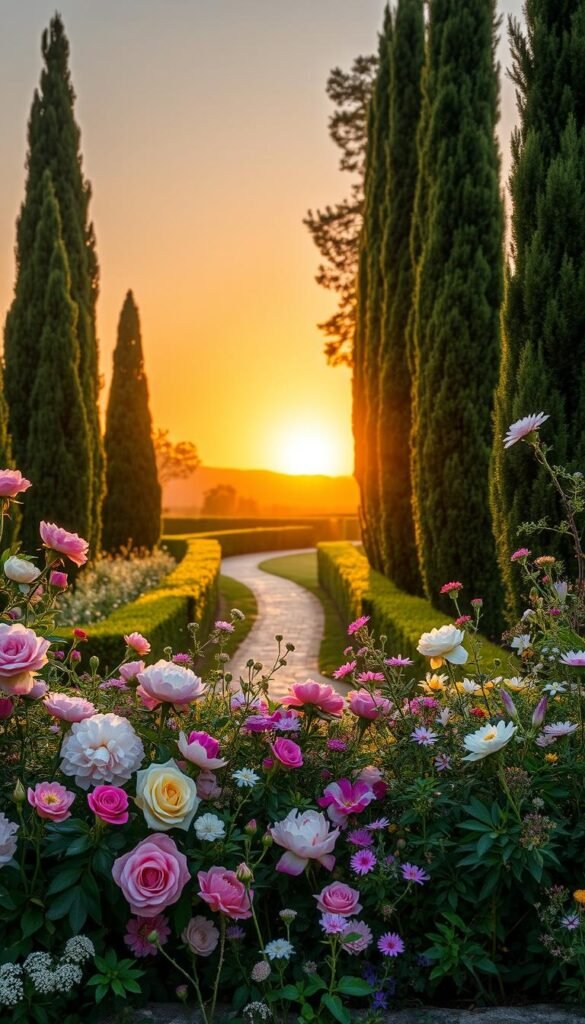
Borders do more than define edges—they shape your garden’s personality. A crisp outline turns wandering flower beds into purposeful compositions, guiding visitors’ eyes while keeping plants contained. Think of them as invisible hands that organize your landscape into digestible visual chapters.
Smart edging solves practical challenges. It stops mulch from spilling onto walkways and blocks invasive grass roots. For sloped yards, borders act as mini retaining walls to prevent soil erosion during storms. Even better? They create optical illusions—curved lines make compact spaces feel expansive, while angular patterns add modern flair.
| Design Style | Best Materials | Plant Pairings |
|---|---|---|
| Formal | Brick, poured concrete | Boxwood hedges, roses |
| Cottage | Weathered stone, pebbles | Lavender, daisies |
| Modern | Corten steel, gabion walls | Ornamental grasses |
| Rustic | Reclaimed timber, logs | Wildflowers, ferns |
Match your home’s architecture for harmony. Ranch-style houses shine with sweeping curves, while Craftsman bungalows demand structured lines. Explore creative gardening ideas that blend hardscaping with perennials for year-round texture. Your choices should reflect both your practical needs and design dreams.
Remember: borders are the silent narrators of your outdoor story. They whisper “this is where relaxation begins” near seating areas or shout “look here!” around prize-winning hydrangeas. Get this foundation right, and every plant becomes part of a greater masterpiece.
Understanding Your Garden’s Edge and Planning Your Layout
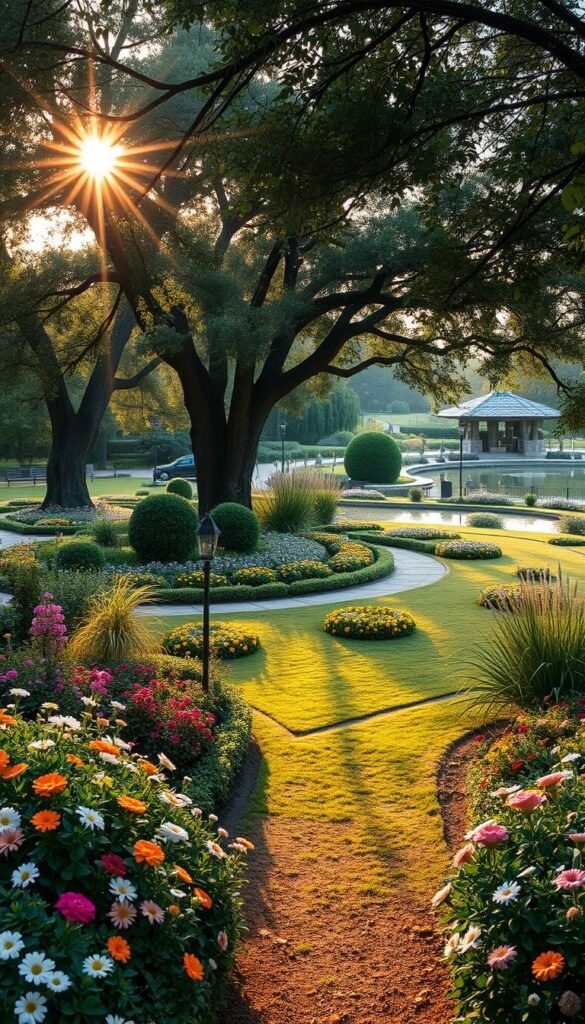
Great landscapes begin with smart preparation. Before reaching for your shovel, take time to study your outdoor canvas. This groundwork ensures your edging solutions solve problems while enhancing natural beauty.
Assessing Your Outdoor Space
Start by digging into your soil’s story. Turn over the top 3-4 inches with a spade, breaking up clumps. Mix in compost or fertilizer to boost nutrients and drainage. Watch how rainwater moves—sloped areas may need borders to stop erosion.
Measure existing trees and shrubs. Leave enough space between mature plants and your planned edge. For new additions, research native species that thrive in your sunlight conditions. A building raised beds approach works well for defined growing zones.
Choosing the Best Edging Materials
Your selection depends on function and style. Heavy rains? Try permeable options like gravel or spaced pavers. Curving paths? Flexible metal strips bend easily. Match materials to your home’s exterior for a cohesive look.
| Material | Best For | Maintenance |
|---|---|---|
| Steel | Modern designs | Low |
| Natural stone | Sloped areas | Medium |
| Recycled brick | Traditional spaces | High |
| Composite wood | Warm aesthetics | Medium |
Consider color contrasts between your lawn and edging. Dark mulch pops against light stones, while weathered wood complements wildflowers. Always sketch your plan—it reveals spacing issues before you start digging.
Elegant Garden Border Ideas to Frame Your Floral Displays

The secret to memorable landscapes lies in how you frame blossoms and greenery. Strategic pairings of materials and plants turn functional edges into artistic statements that evolve with the seasons.
Material Mixology
Combine rough-cut stone with feathery grasses for textural drama that lasts year-round. Try smooth river rocks alongside spiky lavender plants, or pair weathered wood with velvety petunias. These contrasts make both elements shine brighter.
Metal edging offers sleek lines that let colorful blooms take center stage. For cottage charm, use reclaimed bricks as stepping stones through your flower bed. “The best designs balance permanence with seasonal flexibility,” notes a landscape architect from Portland.
Year-Round Color Strategies
Create flowing rainbows by planting warm-toned flowers that transition coolly across your space. Start with fiery red tulips, then blend through golden marigolds to serene blue salvias. For modern edge, try monochromatic schemes – midnight-hued irises paired with snow-white peonies make jaws drop.
English-inspired arrangements bring layered beauty. Tall delphiniums rear behind bushy roses, while foxgloves peek through lower-growing herbs. This approach ensures something always catches the eye, from spring’s first shoots to autumn’s final blooms.
Budget-Friendly Edging Options for Every Garden
Creating beautiful garden edges doesn’t require deep pockets—just smart material choices and clever techniques. With some creativity, you can achieve polished results while keeping costs under control.
Plastic, Glass, and Recycled Solutions
Flexible plastic edging rolls offer durability at a fraction of stone or metal costs. While installation requires trench-digging, these strips create clean lines that last 5-7 years. For quicker setups, pound-in plastic versions work well in straight beds but may shift in freezing climates.
Turn trash into treasure with glass bottle borders. Bury wine or soda bottles neck-down, spacing them 2-3 inches apart. The translucent glass catches sunlight beautifully, creating prism effects during golden hour. “Repurposed materials tell your garden’s story,” notes a Michigan-based landscaper.
| Material | Cost | Installation | Best For |
|---|---|---|---|
| Recycled plastic | $0.50-$1.50/ft | Moderate | Curved paths |
| Glass bottles | Free-$0.25/unit | Easy | Decorative beds |
| Salvaged bricks | $0-$2 each | Challenging | Traditional spaces |
Smart DIY Approaches
Master freehand edging using a flat spade—angle the blade at 45 degrees and slice through turf. This zero-cost method works best when soil is slightly damp. For crisp lines, run a garden hose as your guide before cutting.
Check local construction sites for discarded materials. Many contractors give away broken concrete chunks (called “urbanite”) perfect for rustic borders. Community groups often list free stones or bricks—ideal for filling gaps between permanent edging pieces.
Low-Maintenance, Innovative Border Solutions
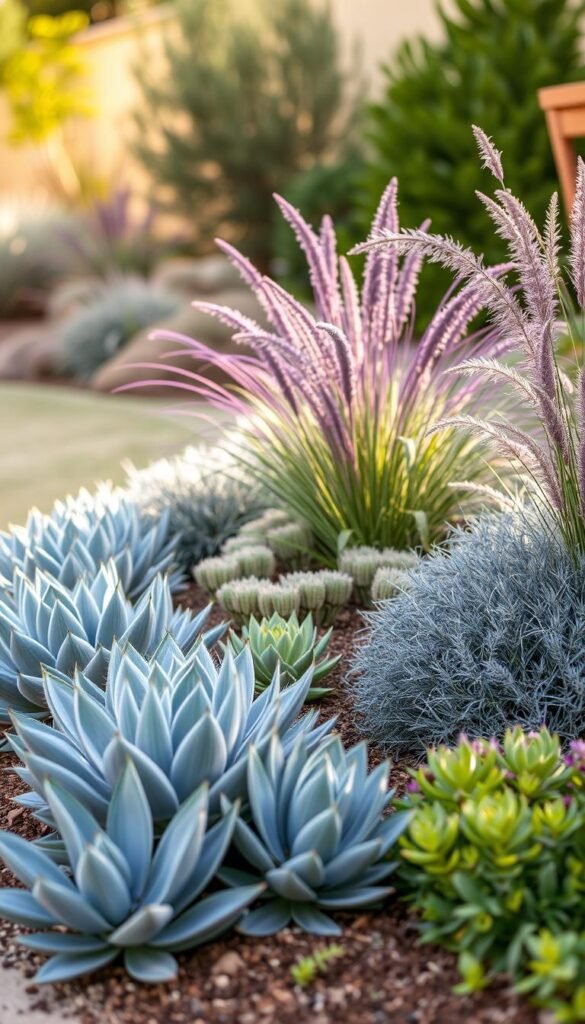
Smart landscaping balances beauty with practicality. For those seeking polished edges without constant upkeep, modern solutions blend efficiency with natural charm.
Efficient Hand Edging Techniques
Sharp spades create crisp lines that make beds pop. Cut at a 45-degree angle when soil is slightly damp for clean slices. This method lets you reshape borders as plants expand, adapting to your evolving landscape.
While hand edging needs yearly refreshing, it costs nothing and offers unmatched flexibility. “A well-cut edge frames your garden like a tailored suit,” says a Colorado landscaper. Pair this technique with mulch to reduce weed growth between maintenance sessions.
| Method | Effort | Cost | Best Use |
|---|---|---|---|
| Hand Edging | High (annual) | $0 | Changing layouts |
| Coco Fiber Mats | Low | $1.50/ft | Weed control |
For natural-looking borders, try coco fiber edges. These biodegradable mats block weeds while letting water through. Secure them with landscape staples and cover with bark mulch – you’ll get instant definition that lasts 2-3 seasons.
Combine methods for best results. Use hand-cut edges near prized plants and coco mats along walkways. Explore more creative garden edging ideas that save time while keeping your space tidy. The right mix reduces work and lets your greenery shine.
Curb Appeal with Stone, Brick, and Concrete Edging
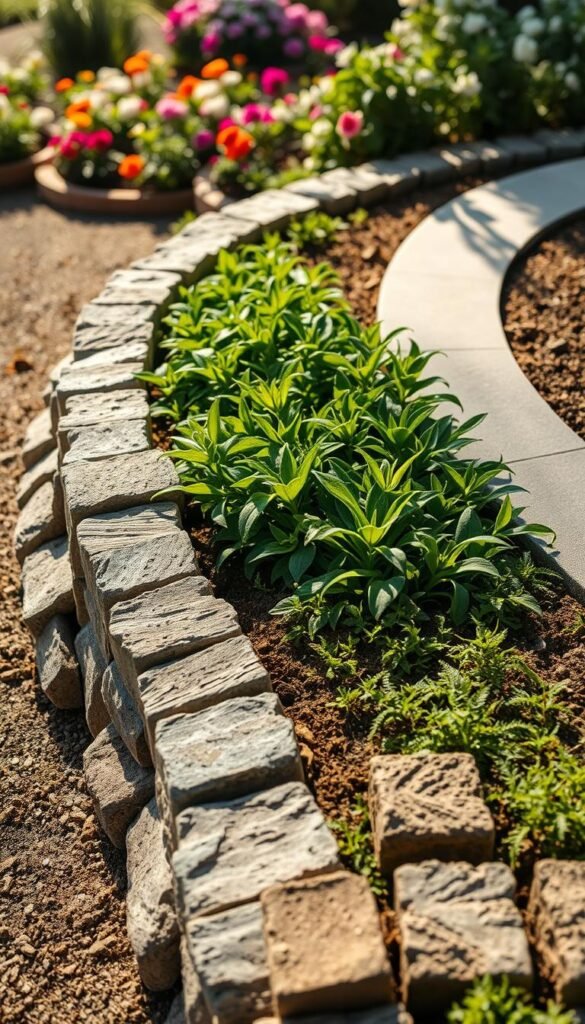
Transform your yard’s first impression with materials that blend strength and style. These classic options create clean lines while resisting weather wear. Their permanence adds value to your property, making them smart investments for lasting beauty.
Stone and Gravel Combinations
Start by digging a 4-inch trench along your bed’s edge. Add flexible plastic strips if you want crisp boundaries. Fill the base with gravel—crushed granite works well for drainage. Top with flagstones or river rocks for natural texture.
| Material | Best Use | Installation Tip |
|---|---|---|
| Pea Gravel | Curved paths | Use edging liner |
| Fieldstone | Sloped areas | Lay flat sides up |
| Lava Rock | Desert themes | Wear gloves |
Brick Wall Advantages and Design Tips
Brick walls add structure that keeps soil contained. For stability, hire a mason to build a footer below frost lines. “Properly installed brick edging lasts 25+ years,” says a Virginia contractor. Match brick colors to your home’s trim for cohesion.
Concrete walls offer similar benefits but need professional forming. Both options require drainage gaps every 4-6 feet. Pair with drought-tolerant plants to elevate your garden’s aesthetic without constant watering.
“Stone and brick edges act like jewelry for your landscape—they make everything else shine brighter.”
Rustic Charm: Wood, Timber, and Log Borders
Natural wood elements bring warmth to outdoor spaces while defining planting areas. These organic materials age gracefully, blending with your landscape instead of competing with it. Let’s explore options that balance affordability with rugged beauty.
Weather-Resistant Wood Choices
Eucalyptus edging offers casual elegance for warm climates. At $7 per linear foot, its silvery-gray tones complement coastal or tropical gardens. Hammer pieces into place with a rubber mallet—no special tools needed. This low-maintenance option lasts years without staining or sealing.
Cedar provides aromatic charm but requires careful placement. Use shingles or shake-style fencing near beds, keeping them clear of lawn equipment. Though prone to trimmer damage, cedar’s natural rot resistance makes it ideal for damp zones.
Repurposed & Budget-Friendly Solutions
Turn fallen trees into free borders. Cut logs into 12-inch sections and bury them halfway around your yard’s flower beds. This approach adds authentic “backyard storyteller” appeal. For structured edges, pressure-treated landscape timbers withstand decay. Cut them to size with a basic saw—perfect for geometric designs.
Wood’s versatility lets you create edges that feel intentional yet unfussy. Whether using fresh materials or salvaged pieces, these borders ground your garden with earthy character that metal or stone can’t replicate.

